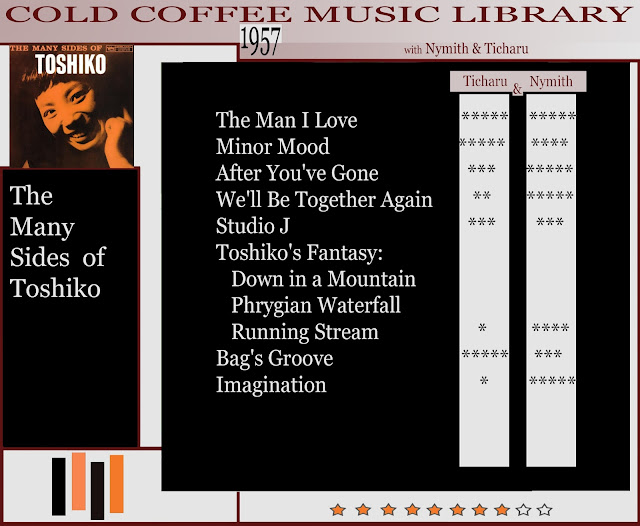WHAT NYMITH SAYS
Having mastered the art of blistering speed and dynamic and then the opposing art of tonal sophistication and phrasing, by 1957 Toshiko set out to combine the approaches, making the album title more than just a random marketing move. The Many Sides of Toshiko, indeed. It might even make the best all-around introduction to her work provided you can find a copy.
The Gershwin classic 'The Man I Love' starts the album with a return to the swoonworthy romantic piano of 'Laura' off the first album - a captivating choice for the leadoff track and bookended by the choice of 'Imagination' for the final number. After the rather Spartan feel of The Toshiko Trio, there's a real infusion of colour and energy this time that gives the album a fuller sound even though she's still heading a trio. This time, with Jake Hanna on drums and Gene Cherico on bass, neither of whom had any special star power in the jazz world but who clearly gelled with her sound - and Cherico remained a semi-permanent fixture, recording with her right up to the 80s.
There's a balanced mix of moods to The Many Sides. 'After You've Gone' (a song that was a number one hit in 1919!) is given a loose, playful reading that undercuts the pathos quite mischievously right to the very end. Going by sound, 'Toshiko's Fantasy' is of a swinging Arcadia where no one gets too worked up but they know the importance of the groove. The nine minutes of 'We'll Be Together Again' start in sunny optimism with Hanna supplying an endless series of drum flourishes; Toshiko then smoothly deepens the tone and the drumming disappears, Cherico stepping into the gap with a hypnotic bass riff over which Toshiko moodily creates an atmosphere of shadows. When Hanna kicks back in and energy returns it's almost a pity.
Faster material tends to include little quotations from her first album, which irked me at first until I remembered that Toshiko's Piano had basically vanished off the face of the earth by that point in time and hardly anyone could be expected to recognise it in America or Japan. Nevertheless, for those who've been lucky enough to hear Toshiko's Piano, 'Bag's Tune' is a bit superfluous. Other than that, this record is golden. I have no honest idea why Toshiko is given so little attention by the jazz community. I hope it's not because she's a woman or Japanese. Perhaps it's all to do with the prevailing idea that "lead instruments" in jazz are saxophone and trumpet, leaving Toshiko in the same sad state as Chico Hamilton, The Modern Jazz Quartet and others who thought piano, cello, vibraphone and flute could dare usurp the role.
WHAT TICHARU SAYS
I like Toshiko. She plays with personality, alternates dark and light, seems to possess a musical sense of humour and has amazingly fluid fingers. Expectations being fairly high I wasn't disappointed, plenty of all those elements on this record. The "many sides", yes she could be a lounge artist, classical interprenator (I made that word up) avant-gardist, be-bop-hard-bop-whatcha-call-it and so much more!
That said, on this record we just have the trio, piano, bass and drums. The inventiveness holds my attention for the most part but at times it's a bit conventional and seems to run thin on ideas, repeating overly simplistic phrases. Why do I expect jazz to be packed with ideas? I hold jazz to fairly unrealistic fantasy heights in which musical genres and statements pass through the players at breathtaking speed simultaneously evoking pathos, melancholy and joy of life with memorable melodic passages that never ever repeat.
Toshiko makes me think jazz like that is possible and there are some moments here that come close.
Cover Critique: The amber-lit happy smiling face of Toshiko. I always prefer aloof mystique but it doesn't look fake. The artist as approachable human being. Three stars. Nymith
She's happy, I'm happy, play it again! Ticharu




No comments:
Post a Comment